Sabbatical Notice: It is hard to read and write at the same time. I am way behind on my book reading because of Hot Stove and some recent political writing (more on that later in this post). So Hot Stove is going on sabbatical. Rita and I head to Miami on Saturday to catch a cruise ship to Cuba – spending my 75th birthday in Havana. The trip after that will be the Telluride Film Festival over Labor Day Weekend. After Telluride, Hot Stove will return, though not likely reporting on the Royals approaching the playoffs. But I will have some movie reviews and more baseball nostalgia and trivia.
KC Blues Scorecard: Although my Mickey Mantle baseball card is long gone, I still have a nice piece of Mantle memorabilia. In 1951, the summer I turned 10, my parents took me to some Kansas City Blues games. I have a couple of the scorecards from those games, and here is the one that prompts this story:
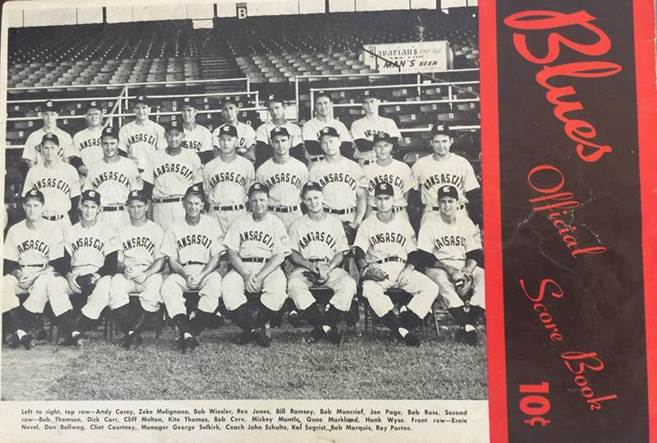
In the second row, third from the right, is Mickey Mantle. He was not supposed to be in this photo or with the Kansas City Blues at all that year. After playing Class C ball in the Yankee farm system in Joplin in 1950, Mantle leapfrogged over Classes B, A, AA and AAA, to make the 1951 Yankees roster. He was heralded as the successor to Joe DiMaggio. The Yankees were so sure that he was to be the next big star that they gave him uniform number 6 to follow Ruth (3), Gehrig (4) and DiMaggio (5). Third baseman Bobby Brown had worn number 6 since 1947, but stepped aside for the rookie phenom.
Mickey Mantle – Opening Day 1951 at Yankee Stadium: Mickey was introduced to New York fans by fellow rookie Bob Sheppard who was the new public address announcer for the Yankees. Mantle was wearing number 6 and playing right field alongside Joe DiMaggio in center. Mickey was a country boy in a big city and got off to a slow start. His attitude and skills suffered and he sometimes lost his temper. Some press stories were not kind about the purported successor to Joltin’ Joe. He was also in the early stages of the drinking and carousing that marked much of his career. In mid-July, the Yankees acquired pitcher Art Schallock from Brooklyn and needed a spot on the roster. The Yankees considered this a good opportunity to send Mantle to its AAA farm team in Kansas City to regain his swing. Mantle was in tears when manager Casey Stengel gave him the news, and Mickey feared his career might be over.
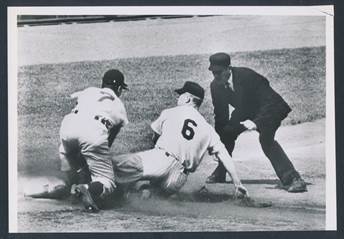
Mickey Wearing #6
[Trivia Break: Bob Sheppard was the public address announcer for the Yankees from 1951 to 2007. In 2008, Derek Jeter asked Sheppard to record his introduction of Jeter, and that recording was used until Jeter retired in 2014. Sheppard, who died in 2010, even did an All Star Game version, knowing that Jeter would often be playing in that game: (click here, 0:26)]
Mickey Mantle and the Blues: Jane Leavy in her stellar biography on Mantle (The Last Boy) recounts in detail the extremes of Mantle’s time in Kansas City. Mickey’s attitude and batting swing did not initially improve. He called his father Mutt and said he wanted to come home. Mutt and other family members came up to Kansas City from Oklahoma. They met at the Aladdin Hotel, and Mickey was crying and embarrassed because he was letting his father down. Mutt said “If that’s all the man you are, then get your clothes and let’s go home.” Instead of a pep talk, Mickey got parental fury. Mutt said Mickey was a coward and should just come back home to work in the mines. Mutt went back home and Mickey had to make a decision to go home or go with the team for a three-week road trip.
For the good of baseball history, Mickey stayed with the team. And his bat got hot. Even with his slow start, he ended up with great stats for his 40 games with the Blues: an average of .361 , 11 homers and 50 RBI’s. By late August, he was headed back to the Bronx for the rest of his career.
Mickey Mantle and Number 7: After Mantle was sent down to the Blues, Bobby Brown reclaimed his old number 6. Upon Mantle’s return to the Yankees, the next available number was 7, last worn by Bob Cerv who had been sent back down to the Blues when Mantle was called up. Cerv and Mantle had overlapped in Kansas City – he is to the right of Mantle in the team photo above. The photo below with DiMaggio was taken after Mickey returned to the Yankees from Kansas City. Mantle would be the last Yankee to wear number 7, one of the most recognizable numbers in baseball history.
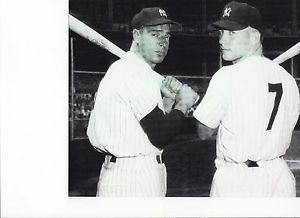
Mickey’s uniform number is part of a classic Seinfeld episode. George Costanza tells his fiancé Susan that he plans to name his child “Seven” in honor of Mickey Mantle. Susan is not pleased: (click here, 1:26). Susan’s objection becomes moot as Seinfeld regulars will recall.
Yankee Single Digit Numbers: The Yankees have retired all of their single digit numbers except one – Derek Jeter’s number 2, but that is just a matter of time. The numbers of Ruth (3), Gehrig (4), DiMaggio (5) and Mantle (7) were retired long ago. Bobby Brown’s number 6 went on to be worn by several players, but it was retired in honor of manager Joe Torre who led the team to four world championships. Number 8 is retired on behalf of two catchers, Bill Dickey and Yogi Berra. Roger Maris was number 9. Number 10 is two digits, but I will mention because it is retired in honor of my childhood baseball hero, Phil Rizzuto. All of these Yankees are in the Baseball Hall of Fame except Jeter (who will be as soon as he becomes eligible) and Roger Maris (who arguably should be in).
Number 1 is also retired by the Yankees, but not to a Hall of Famer (nor should he be). Billy Martin. I separate this one out to tell another story from Jane Leavy’s book. Martin’s temper was well known, including a big chip on his shoulder. Mantle told Leavy that Billy Martin was the only guy he knew who “could hear someone give him the finger.” Great line. Martin is a big part of a funny rant by the faux George Steinbrenner on Seinfeld: (click here, 1:17). As Seinfeld aficionados know, the voice of Steinbrenner is Larry David, the star of Curb Your Enthusiasm and the guy who has been doing the spot-on impressions of Bernie Sanders on Saturday Night Live.
Mickey Mantle and the Kansas City A’s: In 1955, the Philadelphia Athletics moved to KC, and my major league loyalty transferred from the Yankees to the A’s. I was in the 8th grade and went to over 20 A’s games that summer with my friend Jay DeSimone. We sometimes scored autographs from the visiting players, usually on the back of a scorecard. Below is my Mickey Mantle autograph that ends in the Schlitz beer bottle. Other autographs on this scorecard are Phil Rizzuto, Billy Hunter and Art Schallock (the pitcher who bumped Mantle off the Yankee roster back in 1951).
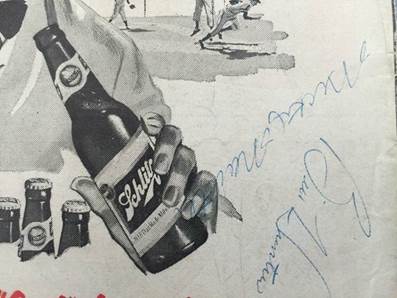
Larry Ray: As covered in Hot Stove #21, Walt Lochman was the voice of the Blues in my parents’ generation. The Blues’ announcer for my generation and when Mickey was here was Larry Ray who did the play-by-play from 1949 to 1954. He was joined in 1954 by Merle Harmon, and they continued together with the Kansas City A’s in 1955 and 1956.
Baseball as Political Metaphor – Revisited: Over the last couple of weeks, I sent out a 3-part series on political campaigns in Kansas City, ranging from Pendergast to Carnahan. Many of you on the Hot Stove list are also on my “political” list and have already seen this (so you can skip), but I wanted to share this excerpt on baseball metaphors with the broader Hot Stove readership. Consider this a follow-up to the Abraham Lincoln political cartoon full of baseball metaphors that you saw in Hot Stove #5.
To set the stage: City races in KC are nonpartisan and so no “D” or “R” appear on the ballot. However, as the 1979 Mayor’s race got underway, no Republican had been elected Mayor since 1924. Incumbent Charles Wheeler was running for a third term, hoping that his quirky and maverick style still had appeal. Four members of the City Council also wanted the office. Bruce Watkins was trying to become the first black mayor. Richard Berkley, a prominent Republican, had major Democratic support and strong funding. Joel Pelofsky and Joe Serviss had some good Democratic support, but not much in campaign funds.
Since I had been active in local politics in the 1970’s, I was occasionally called upon by the newspaper for comments on the elections. While browsing newspaper clippings during my research, I came across a 1979 Kansas City Times article that described me as having “devised an elaborate baseball scenario for the election.” I did not remember this at all, but apparently there was a latent Hot Stove brain working 37 years ago. It went like this:
I likened Dick Berkley to George Steinbrenner, well-heeled owner of the Yankees, who was accused of buying pennants. As an example, I said that Berkley had hired away Wheeler’s political strategist Jerry Jette, reportedly to keep Jerry from working against Berkley. I compared this political free agency to the Yankees signing Luis Tiant to keep Tiant from beating them as a member of the Red Sox in a close pennant race. The cash-light Pelofsky was Bill Veeck, hustling owner of the White Sox who seemed to be holding his franchise together with chewing gum. Charlie Wheeler was of course Charlie Finley (remember, also quirky and a maverick). My copy of the article stops there, but I am pretty sure I would have said Watkins was Jackie Robinson, attempting to become the first black Mayor. Serviss had dropped out, so you could say he was on injured reserve (he would suit back up and run four years later).
The election results: Berkley and Watkins survived the primary and Berkley won the general. So, Watkins did not become KC’s mayoral Jackie Robinson, but he laid the foundation for Emanuel Cleaver to break that barrier in 1991. Cleaver was succeeded by the first woman mayor, Kay Waldo Barnes. Will similar history be made in the 2016 race for President, i.e., will the first black President be followed by the first woman President? There is even a baseball metaphor for Kay and Hillary: “A League of Their Own.” And Trump? If the New Yorker continues to surprise the establishment and wins, it would be like the Amazin’ Mets in 1969. If not, maybe he will be remembered as the Billy Martin candidate who “could hear someone give him the finger.”
Triple Play Trivia: A new first in baseball occurred last week, a 3-3-5 triple play. The Nationals were ahead 4-1 in the bottom of the eighth, but the Giants were threatening with the bases loaded and no outs. Washington brought in a new pitcher and did a double switch by having the pitcher replace the first baseman and vice-versa. The new first baseman, Ryan Zimmerman, would then be scheduled to bat second in the top of the ninth in the pitcher’s slot. The next batter lined out to Zimmerman at first, he stepped on first to double off the runner and then threw to third to triple off the runner who had gone home on the mistaken belief that Zimmerman has short-hopped the ball. The first 3-3-5 triple play in baseball history: (click here, 0:44). The trivia continues. In the top of the ninth, the first batter for the Nationals singled. Zimmerman, batting as planned in the pitcher’s slot, hit into a double play. He was directly responsible for five straight outs in the game, three on defense and two on offense. The Nationals won 4-1.
Golf Note: As Rita and I get ready to head to Cuba, it is a good time to again show Buck O’Neil in his Cuban League uniform from 1947. This artwork is being used to promote the annual Buck O’Neil Golf Classic in support of the Negro Leagues Baseball Museum. I still love Buck’s line: “I shoot my age but that ain’t a good score any more!” – after he shot a 94 at age 94.
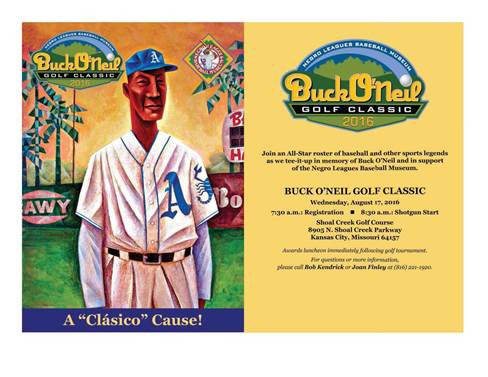
See you in September.
Lonnie